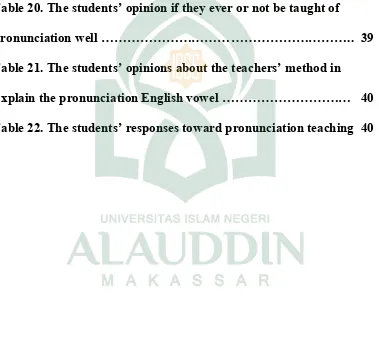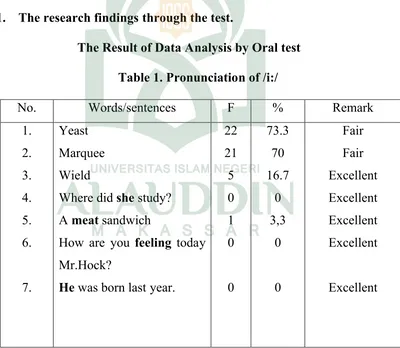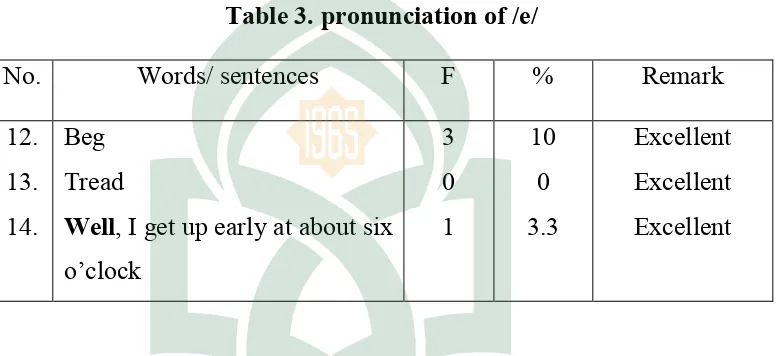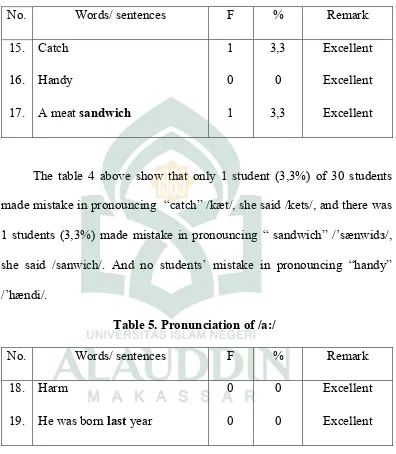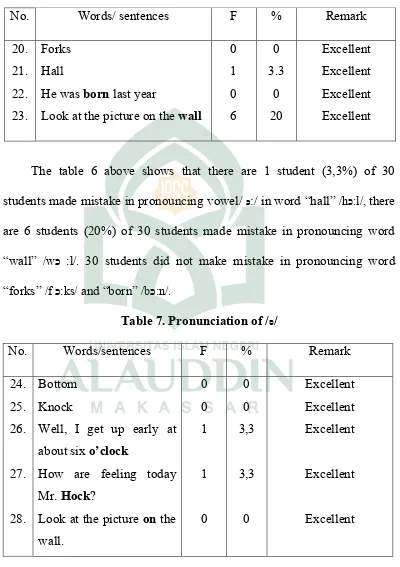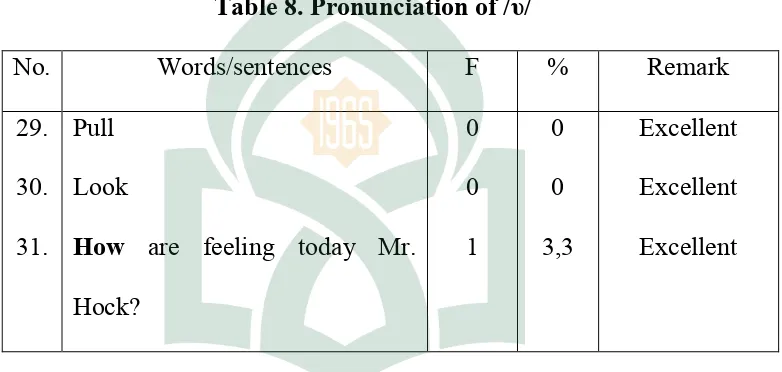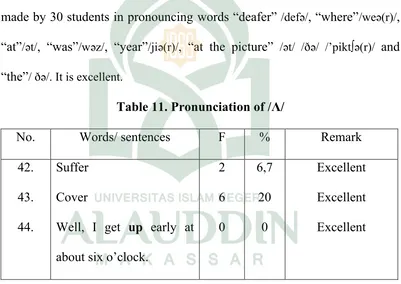i A Thesis
Submitted in Partial Fulfillment of the Requirements for the Degree of Sarjana Pendidikan in English Education Department of
Tarbiyah and Teaching Science Faculty State Islamic University of
Alauddin Makassar
By:
ST.RAHMATIA RAZAK Reg. No. 20401106045
ENGLISH EDUCATION DEPARTMENT TARBIYAH AND TEACHING SCIENCE FACULTY STATE ISLAMIC UNIVERSITY OF ALAUDDIN MAKASSAR
ii
hari, skripsi ini terbukti merupakan duplikat, tiruan atau dibuat orang lain
secara keseluruhan atau sebagian, maka skripsi dan gelar yang diperoleh
karenanya batal demi hukum.
Makassar, September 2010
Penulis,
ST.RAHMATIA RAZAK NIM. 20401106045
iii
20401106045, Mahasiswa Jurusan Pendidikan Bahasa Inggris pada Fakultas Tarbiyah dan Keguruan UIN Alauddin Makassar, setelah dengan seksama
meneliti dan mengoreksi skripsi yang bersangkutan dengan judul “ The Students’ Difficulties in Pronuncing The English Vowel at The Third Year of SMAN 1 Pitumpanua Wajo Regency ” memandang bahwa skripsi tersebut telah memenuhi syarat-syarat ilmiah dan dapat disetujui untuk diajukan ke
sidang munaqasyah.
Demikian persetujuan ini diberikan untuk proses selanjutnya.
Makassar, September 2010
Pembimbing I
Prof. Hamdan, M.A, Ph.D NIP. 19701231 199603 1 005
Pembimbing II
iv
disusun oleh saudari St.Rahmatia Razak, NIM: 20401106045, mahasiswi Jurusan Pendidikan Bahasa Inggris pada Fakultas Tarbiyah dan Keguruan UIN Alauddin Makassar, telah diuji dan dipertahankan dalam sidang munaqasyah yang diselenggarakan pada hari Senin, tanggal 8 Nopember 2010 M bertepatan dengan tanggal 1 Dzulhijjah 1431 H, dan dinyatakan telah dapat diterima sebagai salah satu syarat untuk mendapatkan gelar Sarjana Pendidikan (S.Pd) pada Fakultas Tarbiyah dan Keguruan Jurusan Pendidikan Bahasa Inggris, dengan beberapa perbaikan.
Makassar, 8 Nopember 2010 M 1 Dzulhijjah 1431 H
DEWAN PENGUJI
Ketua : Drs. H. Muhammad Yahya, M. Ag (.………) Sekretaris : Dra. Hamsiah Djafar, M. Hum (.………) Munaqisy I : Dra. Kamsinah, M. Pd. I (...…….………) Munaqisy II : Dra. St. Azisah, M Ed. St (....…….………) Pembimbing I: Prof .Hamdan, M. A, Ph. D (….………) Pembimbing II : Drs. Muh. Yaumi, M. Hum, M.A (.………)
Diketahui Oleh:
Dekan Fakultas Tarbiyah dan Keguruan UIN Alauddin Makassar
v
the writer could finish this thesis. Salam and salawat are addressed to the final
chosen, the prophet Muhammad SAW.
The writer realizes that in writing this thesis, there are many people who
have given her assistance encouragement and useful advice. Therefore, she
wishes to express her greatest thanks to them, especially to:
1. Her beloved parents, Abd.Razak and Hj. Mase Intang who always
sacrifice, pray of safety, health and every success.
2. Prof. Hamdan, M.A, Ph.D and Drs. Muh. Yaumi, M. Hum, M.A as her
consultants who have always given the meaningful suggestion, and
guidance in writing this thesis.
3. Prof. Dr. Azhar Arsyad, M.A as the Rector of UIN Alauddin Makassar.
4. Prof. Dr. H. Moh. Natsir Mahmud, MA as the Dean of Tarbiyah
Faculty,
5. Dra. Djuwariah Ahmad, M. Pd., M. TESOL as the Head of English
Education Department.
6. Dra. Kamsinah, M. Pd. I as the secretary of English Education
vi
during my studies at State Islamic University of Alauddin Makassar.
8. Baso Passamula, S.Pd. M. Si, as the Headmaster of SMAN 1
Pitumpanua Wajo Regency, who has permitted the writer to conduct
this research in the school.
9. Tati Yanti Sukma, S.S, S. Pd as the English teacher of SMAN 1
Pitumpanua Wajo regency, who has given some guidance and useful
advice to the writer.
10. The students of SMAN 1 Pitumpanua Wajo regency, especially the third
year students in academic year 2009-2010 of class XII IPA 1, who have
participated in the research.
11. Her brothers Muhammad Shabri Razak S.Pd.I and his Wife A. Anugrah
Merdekawati, S.Ip, to her sister St. Rajiah Razak S.Ag and her husband
Sakwan Kadir, S.Ag, for their support, love, and understanding.
12. Her classmate in English Education Department (PBI 3&4 the 2006
generation), best friends Irma, Mira, Asmi, Uchy, Mia, Dian, Mery,
vii
Momo, Hasda , Emma, Enhy La orengs, Anca, Krezy, Rudy, Misbah,
K’ Rido’, Irma cemot, Cu’, Wangsa, Keda’, Ade, Syam, Nurul, and
Syita . Thanks for friendship, advice, support, motivation and help.
14. All people whose names could not all be mentioned here, for their help,
services, idea, suggestion and advises in completing this thesis, that
have not been possible for him to acknowledgment all properly.
Finally, we just hope to Allah SWT. Wish this thesis could give
meaningful contribution, information and knowledge for us.
Makassar, September 2010
viii
CHAPTER I INTRODUCTION……… 1
A. Background ……… 1
B. Statement of Problem ………. 3
C. Objective of the Research ……….. 3
D. Scope of the Research ……… 3
E. Significance of the Research ……… 4
CHAPTER II REVIEW OF RELATED LITERATURE ……… 5
A. Previous Research Findings ……… 5
B. Some basic concept ………. 7
CHAPTER III METHOD OF THE RESEARCH ……… 22
A. Kind of Research ……….…… 22
B. Location and the Time of Research ……… 22
C. Subject of Research ……… 22
D. Instrument of Research ……… 23
E. Procedure of Collecting Data ……… 23
F. Technique of Data analysis ……… 23
G. Position of Researcher ……… 24
CHAPTER IV FINDINGS AND DISCUSSION ………25
A. Findings ………... 25
ix
APPENDIX A ………46
APPENDIX B ……… 47
APPENDIX C ………48
x
Table 3. Pronunciation of /e/ ……… 27
Table 4. Pronunciation of /æ/ ……….. 28
Table 5. Pronunciation of /a:/ ……….. 28
Table 6. Pronunciation of /כ:/ ... 29
Table7. Pronunciation of / / ……… 29
Table 8. Pronunciation of / / …………... 30
Table 9. Pronunciation of /u:/ ……….. 31
Table 10. Pronunciation of /ә/ ………... 31
Table 11. Pronunciation of/Λ/……….. 32
Table 12. Pronunciation of /з/ ……… 33
Table 13. The students’ opinion about English teaching in SMAN 1 Pitumpanua Wajo regency ………. 34
Table 14. The students’ opinion about the right pronunciation is important in speaking English ……… 35
Table 15. The students’ opinion about teachers’ attention when they do mistake in pronunciation ……….. 36
xi
Table 19. The students’ way if they got difficulties in pronouncing English vowel ………... 38 Table 20. The students’ opinion if they ever or not be taught of
xii
English Vowel at The Third Year of SMAN 1 Pitumpanua Wajo Regency”
Supervised by : 1. Prof. Hamdan, M.A, Ph.D
2. Drs. Muhammad. Yaumi, M. Hum, M.A.
This research aimed to find out what vowel sounds are difficult to be pronounced by the students and what factors make the students difficult to pronounce the English vowel at the third year of SMAN 1 Pitumpanua Wajo regency. It employed a descriptive method that consisted of two kinds of instruments, there were oral test that consisted of 30 items and questionnaire that included 10 items.
The subjects of the research was the third year students of SMAN 1 Pitumpanua Wajo Regency in academic year 2009-2010 namely class XII 1 IPA that consisted of 30 students. The data were collected through questionnaire and oral test, and were analyzed qualitatively and quantatively.
CHAPTER I
INTRODUCTION
A. Background
Language has an important part in our communication, people need to communicate to each other. English as foreign language has been established as important in the world. As an international language, English is very important to make one become successful in mastering science and technology, which is why we still need foreign language.
Event though Indonesia students have been learning English for six until twelve years or more, they still could not express their thought in English correctly because there must be some reasons which bring failure of them in mastering English, especially in pronounce English vowels. The failure originated from difficulties in learning foreign language is caused of the differences between the students’ mother tongue and English as target language.
In fact the learners may face some difficulties in the pronunciation when they find new sounds in the target language. A lot of errors made by the students especially to produce English vowels and English consonant in initial and middle position. And the problem made by the students need to solve. For example when the students find the words they did not produce in their mother tongue such as: /ei, /ai/, /au/, /uә/, /eә/, /iә/, /כ:/, /u:/, / כә/, /u:/, /כi/ in their mother tongue. As Ramely (1996:25) who has conducted a
research on pronunciation find that, the student errors in pronouncing English vowels caused from their mother language.
The difficulty might be caused by the fact that in Indonesian language there are only five vowels and three diphthongs, while in English we have twelve vowels and nine diphthongs, (Anas Syafei: 40).
From the arguments above, the researcher concludes that the difficulties in pronouncing the English vowels and diphthongs are the students rarely to hear and pronounce the sound and also there are some different between English vowel and Indonesian vowel.
B. Statement of Problem
Based on the background above, some problems need to be answered from this research:
1. What vowel sounds are difficult to be pronounced by the students of the third year of SMAN 1Pitumpanua Wajo regency?
2. What factors make the students difficult to pronounce the English Vowel at the third year of SMAN 1 Pitumpanua Wajo regency?
C. Objective of the Research
The objective of the research is to find out the vowel sounds which are difficult to be pronounced and to find the factors that make the students of the third year of SMAN 1 Pitumpanua Wajo Regency are difficult to pronounce it.
D. Scope of the Research
The scope of the research is focused on the vowel sounds are difficult to be pronounced and what factors make the students difficult to pronounce the English Vowels at the third year of SMAN 1 Pitumpanua Wajo regency.
E. Significance of the Research
To help them to find out the students’ difficulties in pronouncing English vowel in order that they will teach their students well.
2. Students.
CHAPTER II
REVIEW OF RELATED LITERATURE
A. Previous Research Findings
Many researchers have reported their research about difficulties in pronouncing. Some of the findings of related research are presented in the following section.
Arman Asra (1999: 24) in his research about the difficulties encountered by the third semester students of English education department IKIP Ujung Pandang in learning English pronunciation. He formulated problem statement: (1) what are the difficulties encountered by the third semester students and (2) what the sounds are difficult to produce of the students? The result of his research show that the difficulties of students to produce vowel sounds that are /æ/, /ә/ and consonant sounds between /θ/, /з/, /ð/, /dз/. And some causes of the difficulties of students to produce that
sound resulted from the data presentation and discussions are they could not differentiate the vowel sound of /æ/, /ә/ and consonant sounds of /θ/, /з/, /ð/, /dз/.
errors made by the students in pronouncing fricatives consonants, and (3) what errors made by the students in pronouncing approximants consonants? The result of his research indicate that the students still made some errors in pronouncing English consonant which were skill mispronounced by the students, were in nasal: /m/, /n/, /ŋ/; fricative consonants: /f/, /v/, /θ/, /ð/, /s/, /z/, //, /з/; and approximant consonant: /w/, /r/, /j/. The factor that caused the
students makes errors in pronouncing English consonant were:
a. The different sounds and spelling system of English and Indonesian, b. The consistence of English spelling system,
c. Lack of the students knowledge toward the correct pronunciation of English consonants,
d. Lacking efforts of the students learn and practice the English consonants.
students were in nasals /ŋ/, fricative /з/, /ð/, /∫/, and /з/, affricative /t∫/ and /dз/ long vowels /i:/, /з:/, /u:/, /כ: /, and /a:/, and also short vowels
/I/, /el/, /æ/, /ә/, /Λ/, /υ /, and /ס/. The factors that caused the students errors in pronouncing English sound were:
a. The different sound and spelling system of English and Indonesian, b. The inconsistence of English spelling system,
c. Lack of the students knowledge toward the correct pronunciation of English sounds,
d. Lacking efforts of the students learn and practice the English sounds. From the findings above, the researcher interest to research the difficulties in pronouncing English vowels because certain there are many reason about the students’ difficulties in pronouncing English vowels.
B. Some Basic Concepts
1. Difficulties
According to Oxford dictionary (2000:120), difficulty/ies is problem, thing or situation that causes problems.
2. Pronunciation
According to Encarta dictionary in Mustari (2010:10), pronunciation is the way in which a sound, word, or language is articulated, especially in conforming to an accepted standard, can also the act of articulating a sound or word.
Pronunciation refers to the way a word or a language is spoken or the manner in which someone utters the word.
3. English Pronunciation
We cannot pronounce an English word correctly based on its spelling. English spelling is only a poor representation of pronunciation although it must be admitted that there is much regularity between sounds and written symbols. The ordinary spelling of an English word sometimes has a little apparent relation to its sound. There is no one to one correspondence between the sound uttered and the letter which appears in the written word. The spelling of “o” in “door’ and “fool” shows different pronunciations. The letter “o” in “door” is pronounced as /כ:/. On the other hand, the same sound may have various spelling as the sound /כ:/ in “port”, ”stalk,”and “caught.” The sound /כ:/is spelled
/kæ:t. Therefore, it is necessary for the learners to have a clear understanding of the distinctive sounds that appear in English.
4. Vowel
According to Oxford dictionary (2000:483), vowel is speech sound in which the mouth is open and the tongue is not touching the top of the mouth, the teeth, etc.
Vowel is sounds which are made without any kind of closure to the escape of air through the mouth. The tongue plays an essential role in forming vowels.
a. /i:/ : sheep /∫i:p/ b. /I/ : ship /∫Ip/ c. /e/ : bed / /bed/ d. /æ/ :bad /bæd e. /a:/ :father /fa:ðә/ f. / כ:/ : saw /sכ:/ g. /ס/ : lock /lסk/
l. /з/ :bird /bз:d/
` The various vowels and diphthongs selected in this section are those that most likely mispronounced and confused by Indonesian learners. The selection is based on the most common mistake made by Indonesian learners learning English. From my experience of teaching English as a foreign language to Indonesian learners for twenty five years I have observed that not all of the vowel and diphthongs are difficult for Indonesian learners (Anas Syafei, 1988: 40). The sounds that are often mispronounced are:
a.) The vowel /i:/ b.) The vowel /æ/ c.) The vowel /u:/ d.) The vowel /כ:/
e.) Confusing between the quality of the vowels /i:/ and /I/, /e/ and /æ/, /u:/ and /υ/, /a:/ and /Λ/.
5. English Vowels
and the first vowel of suppose are all simple vowels. Diphthongs are vowels that exhibit a change in quality within single syllable. According to (Daniel in Wasis Tri Puspita, 2007:20), a vowel is defined as a voiced sound in forming which the air issues in a continuous stream through the pharynx and mouth, there being no obstruction and no narrowing. According to (Ramelan in Wasis Tri Puspita 2007:20), vowel sounds are, therefore, classified and described on the basis of the following variables:
(1) Which part of the tongue is raised
(2) How high in the mouth some part of the tongue is raised (the degree of the raising the tongue).
(3) The position of the two lips, that is, whether the two lips are rounded or unrounded.
Front central back
i: u: close
I U half -close
∂:
ε ∂
Half-open
æ Λ
a: open (Ramelan in Wasis Tri Puspita, 2007: 20)
(1) / i: /
Articulatory definition:
/i:/ is an unrounded close front vowel Articulatory description:
a. In producing /i:/ the front of the tongue is raised. b. It is raised almost to the close position;
c. The lip position is unrounded or spread, it may even be neutral. d. The jaws are slightly apart from each other.
e. The organs of speech are relatively fortis or tense, which can be felt by putting the fingertips on the muscles bellow the jaws.
See /si:/ Bee /bi:/ Key /ki:/ Eve /i:v/
(2) /I /
Articulatory definition:
/I/ is an unrounded half close to close front vowel Articulatory definition:
a. In producing /I/ the front of the tongue is raised; the raising is somewhat retracted so that it is not really a front vowel, but in between a front and a central vowel;
b. The tongue is raised to a point slightly above the half close position; the tongue position is clearly lower than that for /i:/;
c. The lips are spread or neutral;
d. The jaws are a bit wider than for /i:/. List of words:
Live /lIv/
(3) /ε/
Articulatory definiton:
/ε/ is an unrounded half close to half open front vowel Articulatory description:
a. In producing /ε/ the front of the tongue is raised.
b. The front of the tongue is raised to a point half way between the half open and half close position.
c. The lips position is spread or neutral;
d. The opening between the jaws is medium, a bit wider than for /I/ List of words:
Head /hεd/ Fell /fεl/ Set /sεt/ Bed /bεd/
(4) /æ/
Articulatory definition:
/æ/ is an unrounded open to half open front vowel. Articulatory description:
b. The front of the tongue is raised a little bit to a point midway between the open and the half open position.
c. The lip position is spread or neutral; d. The jaws are rather widely opened. List of words:
Band /bænd/ Land /lænd/
Bad /bæd/ Bat /bæt/ (5) /a:/
Articulatory definition:
/a:/ is an unrounded open back vowel Articulatory description:
a. In producing /a:/ the back of the tongue is raised;
b. The raising is somewhat advanced from the real back position.
c. The raising of the tongue is only slight so that the tongue can be said to be very low in the mouth, and is then at the fully open position. d. Though classed as a back vowel, the lips for the production of /a:/ are
List of words: Harm /ha:m/ Hard /ha:d/ Heart /ha:t/ Barn /ba:n/ (6) /ס/
Articulatory definition:
/ס/ is a rounded open back vowel
Articulatory description:
a. For the production of /ס/ the back of the tongue is slightly raised.
b. The raising of the back of the tongue is so slight that it is almost near the fully open position; thus the tongue is very low in the mouth. c. The lips are slightly rounded, but not protruded.
d. The jaws are rather wide apart. List of words:
Hot /hסt/ Cot /kסt/ Pot /pסt/ Lost /lסs/
Articulatory definition:
/כ:/ is a rounded half open back vowel.
Articulatory description:
a. In producing /כ:/ the back of the tongue is raised.
b. This raising almost reaches the half open position.
c. The lips are more closely rounded than for /ס/, that is, in between
open lip rounding.
d. The jaws are fairly wide apart from each other. List of words:
Caught /kכ:t/ Dawn /dכ:n/ Stalk /stכ:k/ Port /pכ:t/
(8) /U/
Articulatory definition:
/U/ is a rounded half close to close back vowel. Articulatory description:
a. In producing /U/ the back of the tongue is raised; this raising is advanced from the true back position.
c. The lips are fairly closely rounded, and slightly protruded, with no tension of the muscles.
d. The jaws are little bit apart from each other. List of words:
Could /kUd/ Put /pUt/ Cook /kUk/ Fully /fUlI/
(9) /u:/
Articulatory definition:
/u:/ is a rounded close back vowel Articulatory description:
a. In producing /u:/ the back of the tongue is raised; b. It is raised to a point very near the close position. c. The lips are closely rounded with little protrusion. d. The jaws are only slightly separated.
(10) /Λ/
Articulatory definition
/Λ/ is an unrounded half open centro back vowel. (or an unrounded open to half open centro back vowel)
Articulatory description:
a. In /Λ/ some part between the front and the back of the tongue, almost the central part of the tongue, is raised; (thus centro back vowel). b. It is raised to the half open position, or slightly to a point between the
half open and open position;
c. The lip position is unrounded or neutral; d. The jaws are wide apart.
List of words: Bud /bΛd/ Tusk /tΛsk/ Lust /lΛst/ Cud /kΛd/
(11) /з:/
Articulatory definition
/з:/ is an unrounded half close to half open central vowel
a. In producing /з:/ the central part of the tongue is raised; the central part of the tongue is that part of the tongue between the front and the back.
b. It is raised to a point between half close and half open position; c. The lips are rounded or neutral as for /I/;
d. The jaws are slightly separated from each other. List of words:
Lurk /lз:k/ Curt /kз:t/ Hurt /hз:t/ Burn /bз:n/ (12) /ә/
Articulatory definition:
/ә/is an unrounded half open to half close central vowel. Articulatory description:
a. In producing /ә/the central part of the tongue is raised. b. It is raised to the half position, or even lower.
Statement /steitmәnt/ Sofa /soufә/
CHAPTER III
THE RESEARCH OF METHODOLOGY
A. Kind of Research
The kind of the research that used in this research was qualitative descriptive. Sugiono (2010:9) stated that Qualitative research is descriptive, the data collected is in the form of words of pictures or table rather that number. Qualitative researches are concerned with process rather than simply outcomes or products: qualitative researches tend to analyze their data inductively.
B. Location and the Time of Research
The location of this research was SMAN 1 Pitumpanua. The research was conducted from July to August 2010.
C. Subject of Research
The subjects of the research were the students of class XII IPA 1 in SMAN 1 Pitumpanua in academic year 2009-2010 that consisted of 30 students.
D. Instrument of the Research
In collecting data, the researcher used two kids of instruments. They are pronunciation test and questionnaires. Pronunciation test was used to find out the vowel sounds are difficult to be pronounced by them. Questionnaires were used to find out the factors make the students difficult to pronounce the English Vowel.
E. Procedure of collecting data
The data collected through the following procedures, namely:
1. The researcher asked the students to read the text which there are some example of English vowel.
2. One by one of the students read the text, while the researcher recorded their voices and observed the difficulties made by them.
3. Then, the researcher analyzed the data collected. 4. Recording with the camera.
F. Technique of data analysis
Categories Number of mistake in percentage
Excellent Good Fair Poor
0-25 % 26-50 % 51-75 % 76-100 %
G. Position of Researcher
CHAPTER IV
FINDINGS AND DISCUSSION
A. Findings
As the researcher explained at the previous chapter, this research used the oral test and questionnaire. The oral test is used to find out the vowel sounds was difficult to be pronounced and questionnaires to find out factors made the students difficult to pronounce the English vowel.
1. The research findings through the test.
The Result of Data Analysis by Oral test
Table 1. Pronunciation of /i:/
No. Words/sentences F % Remark
1.
Where did shestudy? A meatsandwich
How are you feeling today Mr.Hock?
Hewas born last year.
The table 1 above show that there were 22 students (73, 3 %) out of 30 students mispronunciation in word “yeast “/ji:st/, some of them pronounce /yest/ in this word, this is poor. There were 21 students (70%) out of 30 students mispronunciation in word “marquee” /ma:’ki:/, some of them pronounce /merkiu/, this is poor also. There were 5 students (16,7 %) of 30 students mispronunciation in word “wield” /wi:ld/, they pronounce /waild/. Only 1 student (3,3 %) made mistake in word “meat” /mi:t/ out of 30 students, she pronounce /met/. And there were no mispronunciations in words “she” /∫i:/, “feeling” /’fi:liŋ/ and “he” /hi:/. This is excellent.
Table 2. Pronunciation of /I/
No. Words/sentences F % Remark
The Tabel 2 above show that there were 2 students (6,7%) out of 30 students was mispronouncing in word “lake” /leIk/, theirs pronounce was /lek/. And there were no mispronouncing in word “pick” /pIk/, “I” /aI/, “six” sIks/ and “did” /dId/. It is excellent.
Table 3. pronunciation of /e/
No. Words/ sentences F % Remark
Table 4. Pronunciation of /æ/
No. Words/ sentences F % Remark
15.
made mistake in pronouncing “catch” /kæt/, she said /kets/, and there was
1 students (3,3%) made mistake in pronouncing “ sandwich” /’sænwidз/,
she said /sanwich/. And no students’ mistake in pronouncing “handy”
/’hændi/.
Table 5. Pronunciation of /a:/
No. Words/ sentences F % Remark
18.
The table 5 above show that there is not mistake and difficult made of
30 students in vowel /a:/ in word “harm” /ha:m/ and “last” /la:st/. It is
Table 6. Pronunciation of/ כ:/
No. Words/ sentences F % Remark
20.
Look at the picture on the wall
0
students made mistake in pronouncing vowel/ כ:/ in word “hall”/hכ:l/, there
are 6 students (20%) of 30 students made mistake in pronouncing word
“wall” /wכ :l/. 30 students did not make mistake in pronouncing word
“forks” /fכ:ks/and “born”/bכ:n/.
Table 7. Pronunciation of /ס/
No. Words/sentences F % Remark
The table 7 above show that only 1 student (3,3%) of 30 students made
mistake in pronouncing words “o’clock” /ә’klסk/ and “Hock” /Hסk/. She
pronounces the words are /ekluck/ and /huk/. There is not mistake made by
them in pronouncing “bottom” /’bסtәm/, “knock” /nסk/ and “on” /סn/.
Table 8. Pronunciation of /υ/
No. Words/sentences F % Remark
29.
There is not mistake made by 30 students in pronouncing the word “pull”
Table 9. Pronunciation of /u:/
them pronounce /lәgen/, this is fair. And there is not student of 30 students
made mistake in pronouncing word “fool” /fu:l/, this is excellent.
Table 10. Pronunciation of /ә/
No. Words/ sentences F % Remark
34.
How are feeling today
The table 10 above show that there were 2 students (6,7%) of 30
students made mistake in pronounce word “ligament” /’ligәmәnt/, they
pronounce /ligament/. There were 3 students (10%) of 30 students made
mistake in pronouncing word “A” /ә/, they pronounce /e/ and /ai/. There
were 4 students (13,3%) of 30 students made mistake in pronouncing word
“today” /tә’dei/, they pronounce /tudai/ and /tedei/. There were not mistake
made by 30 students in pronouncing words “deafer” /defә/, “where”/weә(r)/,
“at”/әt/, “was”/wәz/, “year”/jiә(r)/, “at the picture” /әt/ /ðә/ /’pikt∫ә(r)/ and
“the”/ ðә/. It is excellent.
Table 11. Pronunciation of /Λ/
No. Words/ sentences F % Remark
42.
students made mistake in pronouncing word “cover” /kΛvә/, they pronounce
pronouncing word “suffer” /sΛfә/, they pronounce /suffer/. And not students
made mistake in pronouncing word “up” /Λp/.
Table 12. Pronunciation of /з/
No. Words/ sentences F % Remark
45.
made mistake in pronouncing vowel /з/ in word “first” /fз:st/. he pronounce
/firs/. There were mistake in pronouncing word “verse” /vз:st/ and “early” /’
з:li/. It is excellent.
2. The research findings through the questionnaire
The questionnaire that distributed to the students consists of 10
items, in order to find out the factors make the students difficult to
The Result of Data Analysis by Questionnaire
Table 13. The students’ opinion about English teaching in SMAN 1
pitumpanua Wajo regency.
No Responses F %
1
Very interesting
Interesting
Less interesting
Uninteresting
1
26
3
-3,3
86,7
10
-TOTAL 30 100
Table 13 above shows that from 30 students, there were 1 students
(3,3%) said that English teaching is very interesting especially in SMAN 1
Pitumpanua and 26 students (86,7%) said that English teaching is interesting.
There were 3 students (10%) said that English teaching is less interesting, and
none of them said that english teaching is uninteresting. They said like that
Table 14. The students’ opinion about the right pronunciation is
important in speaking English.
No Responses F %
2
Very important
Important
Unimportant
Very unimportant
21
9
-70
30
-TOTAL 30 100
Table 14 above shows that from 30 students, there were 21 students
(70%) said that the right pronunciation in speaking English is very important,
and there were 9 students (305%) said that the right pronunciation in speaking
English is important. Than, none of them said that the right pronunciation in
speaking English is unimportant and very unimportant. They said like that
Table 15. The students’ opinion about teachers’ attention when they do
mistake in pronouncing. They said like that, because their teacher attention
with her students’ English progress.
Table 16. The students’ opinion if they ever or not got difficulties in
Often
(56,7%) ever got difficulty in pronouncing English vowel, 13 students (43,3%)
often got difficulty in pronouncing English vowel, and none students never and
seldom got difficulty in pronouncing English vowel.
Table 17. The students’ opinion that made them difficult in pronouncing
English vowel
(70%) said confused with the pronouncing of English vowel, 1 students (3,3%)
said lazy to study about the pronouncing English vowel and none of them said
Table 18. The students’ opinion in learning pronunciation
(16,6%) said that learning pronunciation is difficult, 23 students (76,7%) said
that learning pronunciation is rather difficult, there was no students said that
learning pronunciation is very difficult, and 2 students (6,7%) said that
learning pronunciation is not dfficult.
Table 19. The students’ way if they got difficulties in pronouncing English
Table 19 above shows that from 30 students, there were 19 students
(63,3%) open the dictionary if they got difficulties in pronouncing English
vowel, 5 sudents (16,7%) asking their teacher if they got difficulties in
pronouncing English vowel while studying in the classroom. 6 students (20%)
asked their friends, and none student doing nothng if they got difficulties in
pronouncing English vowel.
Table 20. The students’ opinion if they ever or not be taught of
Table 21. The students’ opinions about the teacher’s method in explain the
vowel is very interesting, and 20 students (66,7%) said that the method of their
teacher in explain the pronunciation English vowel is interesting. Than, there
were 4 students (13,3%) said that the method of their teacher in explain the
pronunciation English vowel is not interesting, and 2 students (6,7%) felt
boring about the method of their teacher in explain the pronunciation English
vowel.
Table 22. The students’ responses on attention to the pronunciation class
relax but serious 28 93,4
TOTAL 30 100
Table 22 above shows that from 30 students, there were only 1 student
(3,3%) responses that she was serious in attending the class. Only 1 student
(3,3%) responses that he was not serious in attending the class. None students
response that they were absent in pronunciation class. 28 students (93,4)
responses that they were relax but serious in attending the class.
B. Discussion
The result of the research showed that the students of SMAN 1
Pitumpanua Wajo regency got some English vowels is difficult to
pronounce, this case could be seen on data analysis by oral test, and the
English vowel sound which difficult to pronounce by the students are: /i:/
(163%) it is very poor, /I/ (6,7%) it is excellent, /e/ (13,3%) it is excellent,
/æ/ (6,6%) it is excellent, /a:/ (0%) it is excellent, /כ:/ (23,3%) it is
excellent, /ס/ (6,6%) it is excellent, /υ / (3,3%) it is excellent, /u:/ (60%) it
is fair, /ә/(30%) it is good, /Λ/(26,7%) it is good, /з/ (3,3%) it is excellent.
The result of the research through questionnaire showed that the
factors made the students of SMAN 1 Pitumpanua Wajo regency difficult
pronunciation, and (2). They were not serious in attending the class. These
reasons could be seen on the table above completely (data analysis by
CHAPTER V
CONLUSION AND SUGGESTION
A. Conclusion
Based on the findings of the research and discussion, the
researcher concluded that the third year students (class XII 1 IPA) of
SMAN Pitumpanua Wajo regency in academic year 2009/2010 got
some difficult in pronouncing English vowel sound are: /i:/, /u:/, /ә/ and
/Λ/. The factors are: they confused with the sound or to pronounce it
and when they study about pronunciation they were unserious.
B. Suggestion
Based on the conclusion above, the researcher suggests that the
students should learn more about pronunciation because it is important
to make us clear in speaking. Then, the teacher should give explanation
BIBLIOGRAPHY
Ampa, Tenri. 2006. English Pronunciation Practice. English Education
Department. Makassar Muhammadiyah University.
Amalia, Dwi Ardeni. 2010. Error Analysis in Pronouncing English Sound
Made by the Fifth Semester Students of Makassar Muhammadiyah
University. Thesis. Faculty of Teacher Training and education of
Makassar Muhammadiyah University.
Arikunto, Suharsimi. 2006. Prosedur Penelitian Suatu Pendekatan Praktik. Jakarta:PT. Rineka Cipta.
Asra, Arman. 1999. The Difficulties Encountered by The Third Semester
Students of English Education Departmnet IKIP Ujung Pandang.
Thesis. Fakultas Pendidikan Bahasa dan Seni Institute Keguruan dan Ilmu Pendidikan Ujung Pandang.
Arsyad, Ashar. 2005. Dasar-Dasar Penguasaan Bahasa Inggris Melalui Your
Basic Vocabulary. Yogyakarta: Pustaka Pelajar.
Best, J.D. 1981. Research in Education. New Jersey. Prentice Hall Inc.
M. Echols, John and Shadily, Hasan. An English Indonesian-Dictionary. Jakarta: PT Gramedia Jakarta.
Mustari. 2010. Improving Students’ Speaking of Islamic Boarding High School
Callaccu Sengkang Wajo. Thesis S1. Faculty of Tarbiyah and
Teachership UIN Alauddin Makassar.
Nurhamda. 1997. The Students’ Difficulties in Pronouncing English
Sound.Thesis. FBS IKIP. Ujung pandang.
Oxford Learner’s Pocket Dictionary New Edition. 2005. New York: Oxford
University Press
Puspita, Wasis, Tri. 2007. An analysis of Students’ Errors in Pronouncing
English Vowels. Thesis. Faculty of languages and arts, Semarang
State University.
Rameli. 1996. Pronunciation Problems Faced by the Buginess Students of
SMU Barru. Thesis. S1 FPBS TKIP. Ujung pandang.
Rifandi, Rifial. 2008.The Error Analysis in Pronouncing English Consonants
Made by the Third Year Students of SMU Neg.3 Makassar. Thesis.
Faculty of Teacher Training and Education of Makassar
Muhammadiyah University.
Sugiono. 2010. Metode Kualitatif & Kuantitatif R&D. Bandung: CV. Alfabeta.
Syafei, Anas. 1988. English Pronunciation Theory and Practice.Jakarta.
Depdikbud Direktorat Jendral Pendidikan Tinggi P2LPTK.
Syahriani.2007. Difficulties Faced by the Second Years Students of SMA
Pesantren Al-Qamar Kab.Takalar in Identifying the Main Ideas of
APPENDIX A
THE PRONUNCIATION TEST
Read the following words be sure that your pronunce is correct!
1. First
Read the following sentences be sure that your promunce is correct!
25. Well, I get up early, at about six o’clock 26. Where did she study?
27. A meat sandwich.
28. How are feeling today, Mr. Hock? 29. He was born last year.
APPENDIX B
THE KEY OF THE PRONUNCIATION TEST
1. First /fз:st/
24. Ligament /’ligәmәnt/
25. Well, I get up early, at about six o’clock 26. Where did she study?
27. A meat sandwich.
28. How are feeling today, Mr.Hock? 29. He was born last year.
30. Look at the picture on the wall.
APPENDIX C
Questionnaires (angket)
Angket ini bertujuan untuk mengumpulkan data tentang faktor-faktor yang
membuat siswa sulit dalam mengucapkan vowel dalam bahasa Inggris di SMAN 1
Pitumpanua kabupaten Wajo. Untuk itulah peneliti mengharapkan kepada anda agar
dapat memberikan jawaban yang sejujur-jujurnya sehingga hasil penelitian dapat
diperoleh dengan se objektif mungkin. Kejujuran dan kesungguhan anda adalah
harapan peneliti, atas partisipasi anda diucapkan terima kasih.
Petunjuk
a. Jawablah pertanyaan-pertanyaan dibawah ini dengan memberikan tanda silang
(X) pada pilihan yang anda anggap sesuai.
b. Anda dapat bertanya kepada peneliti jika ada pertanyaan yang kurang jelas.
c. Isilah isian berikut ini sebelum menjawab
Nama :
Kelas :
N.I.S :
1. Bagaimana tanggapan anda tentang pelajaran bahasa inggris di sekolah anda?
a. Sangat menarik. c. kurang menarik
b. Menarik. d. tidak menarik.
2. Apakah menurut anda pronunciation yang benar penting dalam berbahasa Inggris?
a. Sangat penting. c. tidak penting.
b. Penting. d. sangat tidak penting.
a. Pernah c. sering
b. Tidak pernah d. jarang
4. Apakah anda pernah mengalami kesulitan dalam pengucapan English vowel?
a. Pernah c. sering
b. Tidak pernah d. jarang
5. Apa yang membuat anda kesulitan dalam pengucapan English vowel? a. Jarang mendengarkan pengucapan tersebut
b. Bingung dengan pengucapannya
c. Tidak pernah mendengarkan pengucapan tersebut d. Malas belajar
6. Bagaimana tanggapan anda dalam mempelajari pronunciation English vowel?
a. Sulit c. Terlalu sulit
b. Agak sulit d. Tidak sulit
7. Bagaimana cara anda mengatasi kesulitan anda dalam pengucapan English vowel?
a. Membuka kamus b. Bertanya pada guru c. Bertanya pada teman d. Acuhkan saja
8. Apakah and pernah diajari cara mengucapkan English vowel yang benar?
a. Pernah c. sering
b. Tidak pernah d. jarang
9. Bagaimana pendapat anda tentang metode mengajar guru dalam menjelaskan pengucapan English vowel?
a. Sangat menarik c. Tidak menarik
b. Menarik d. Membosankan
10. Bagaimana respon anda terhadap pengajaran pronunciation English vowel?
a. Serius c. tidak hadir
APPENDIX D
The Students’ score of pronunciation Test
No Students Number of
Mistake in Percentage
Categories
1 Muh. Firdaus 20 Excellent
2 Hajrah 20 Excellent
3 Angriani 10 Excellent
4 Darul Wardani 13,3 Excellent
5 Andi Hasbullah 16,7 Excellent
6 Erfika 6,7 Excellent
7 Ciwantoro 10 Excellent
8 Emilyang Rusdi 16,7 Excellent
9 Hardianti M 16,7 Excellent
10 Indo Upe A 6,7 Excellent
11 Khaerunnikmah 23,3 Excellent
12 Ahmad 13,3 Excellent
13 Asrul 13.3 Excellent
14 Atira Refita Mutmainnah 16,7 Excellent
15 A .Hardianti 10 Excellent
16 Rita Eka Reski Muliani R 10 Excellent
17 Muh. Arfian 10 Excellent
18 Erni 13,3 Excellent
19 Farida S 20 Excellent
20 Dewi Ratnasari 13,3 Excellent
21 Ade Saputra 6,7 Excellent
22 Nuratika 10 Excellent
23 Irnawati 3.3 Excellent
24 Eka Pratiwi Farouq 13,3 Excellent
25 Amhar Ulfiana 6,7 Excellent
26 Raziqah Isnaeny Majid 3,3 Excellent
27 Andi Tenri Angka 6,7 Excellent
28 Fisma 3,3 Excellent
29 Selly Triana Reski 6,7 Excellent
the
the couple of marriage of her parents: Abd.Razak
Mase Intang.
started her education in MIS As’ adiyah Addamar
Kab. Wajo and graduated in 2000. She continued her
Muhammadiyah Jaupandang Kab. Wajo and graduated in
continued her study in Madrasah Aliyah DDI Tobara
Kab. Wajo and graduated in 2006. In the same year
student in English Education Department, Tarbiyah
Faculty, State Islamic University of Alauddin
